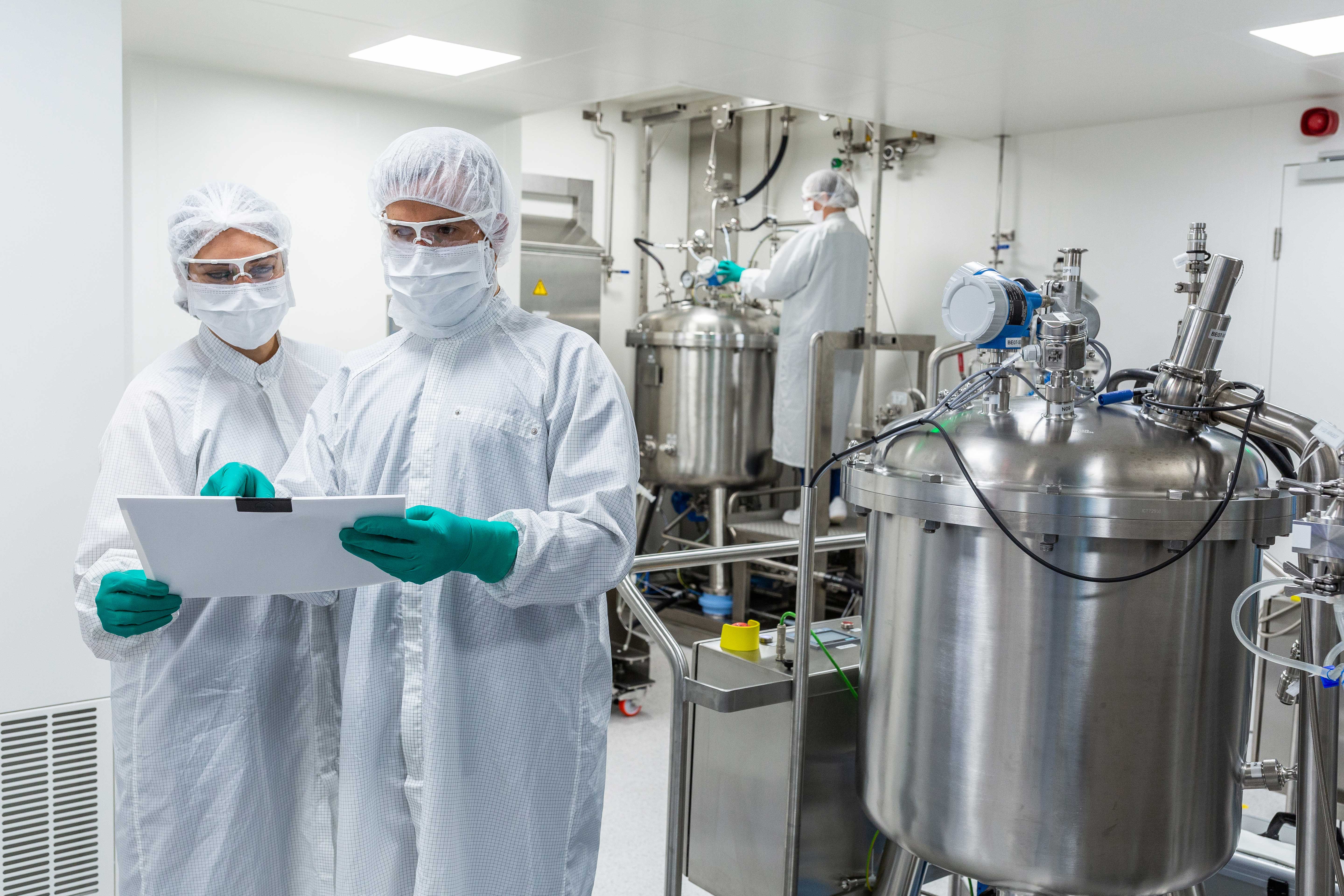Vaccine development
CureVac as a pioneer of mRNA technology – what is behind the novel COVID-19 vaccine?
All eyes are on vaccines against the coronavirus. The Tübingen-based company CureVac is doing pioneering work in this field, and intends to initiate clinical testing of its lead vaccine candidate in June. At the same time, Curevac is manufacturing the material for this vaccine candidate. But that’s not all: the novel mRNA technology also has the potential to revolutionise the treatment of cancer and metabolic diseases. What makes the method so special?
A broad range of strategies in the search for a vaccine against the novel SARS-CoV-2 coronavirus are being explored. Based on previous experience, new vaccine developments take many years or even decades. New technologies and previous knowledge of related viruses are expected to speed up the search for new vaccines. However, of over 130 vaccine projects initiated worldwide, only a few have been able to transition to preclinical or clinical trials. CureVac from Tübingen offers considerable hope. Since the publication of the SARS-CoV-2 sequence in January 2020, the biotech company, with its workforce of around 470, has been working flat out on the development of a coronavirus vaccine based on messenger RNA (mRNA). "We have been working on the development of our mRNA platform for almost 20 years and can draw on our experience with this technology for the ongoing development of a COVID-19 vaccine," said Dr. Mariola Fotin-Mleczek, Chief Technology Officer at CureVac.
Using the body’s own protein factory
 mRNA production in the mRNA technology facility at Tübingen-based CureVac. © CureVac AG
mRNA production in the mRNA technology facility at Tübingen-based CureVac. © CureVac AGAs far as COVID-19 is concerned, the goal is to develop a vaccine that enables the immune system to render the virus harmless through active immunisation. Passive immunisation involves the administration of antibodies as acute therapy, which are, however, broken down after a few weeks. In contrast, active immunisation leads to a long-lasting immune response. Several methods can be used to do this: inactivated vaccines can easily be produced from pathogens that have been killed. In this case, however, it is not always possible to fully activate the immune system; in some cases, these kinds of vaccines even facilitate the entry of viruses into cells. Live vaccines with attenuated, i.e. weakened, pathogens usually generate a good immune response, but the development and manufacturing processes are complex.
There is a promising alternative: gene vaccines that contain the blueprints of the surface protein of the new coronavirus. The key to this approach is that vaccines of this kind deliver the genes that encode proteins of the pathogen into the body and the cells then produce the corresponding viral proteins themselves. However, DNA vaccines with recombinant virus antigens pose an incalculable risk due to the incorporation of foreign DNA. This is where CureVac comes into play: CureVac’s vaccine is produced in the body of the vaccinated individual on the basis of mRNA - without interfering with the genome. This works because RNA acts as an intermediate link between genes and proteins: DNA is first transcribed into mRNA, which then leaves the cell nucleus and is translated into proteins in the cell plasma. "Using mRNA biomolecules, the body can produce both drugs and vaccines," explains Fotin-Mleczek. These vaccine candidates can also be generated, developed and manufactured much more quickly than other processes.
Revolutionary potential of mRNA technology
CureVac's vaccine candidates against the rabies virus and flu viruses have shown in preclinical trails in animals that the vaccine candidates were well tolerated and provided protection against these diseases at a low dose. CureVac has also demonstrated in clinical phase 1 trials that low-dose rabies virus candidates produced a balanced immune response in healthy volunteers. This can be deduced from the large number of virus-neutralising titres and T cells – the dream of every scientist working in prophylactic vaccine development where a complete immune response is desired: The goal is to achieve an activation of B lymphocytes or secreted antibodies as well as T killer cells, regulatory T cells and memory cells. "As far as SARS-CoV-2 is concerned, preclinical trials involving animals have also shown that low vaccine doses of only two microgrammes have led to positive results," says Mariola Fotin-Mleczek, who is quite pleased with these results.
 Dr. Mariola Fotin-Mleczek, Chief Technology Officer of the mRNA technology leader CureVac. © CureVac AG
Dr. Mariola Fotin-Mleczek, Chief Technology Officer of the mRNA technology leader CureVac. © CureVac AGThe key challenge is to prepare the artificially produced mRNA in a stable way. Pure RNA is quickly destroyed by phagocytes and enzymes in the blood of vaccinated individuals. Even RNA that is delivered using recombinant carrier viruses can be recognised as an intruder after fusion of the viral membrane with the host cell membrane, and is subsequently eliminated. CureVac has developed an optimisation technology: the biomolecule is modified at its two ends, the 5’ and 3’ untranslated regions, to make it stable. The so-called open reading frame, which encodes the desired protein, is also customised. The RNA is equipped with an enhancing promoter sequence so that it can be transcribed preferentially in the cell. Repetitive sequences ensure that sufficient quantities of the desired protein are produced.
The RNA construct needs to be encapsulated in order to prevent it from being degraded after it has entered the cell. The biotechnologists at CureVac encapsulate the RNA in a protective shell of lipid nanoparticles (LNPs). These LNPs need to appear "harmless" as they become quite large after encapsulation of the mRNA. The goal is to prevent a cytokine storm of the immune system from occurring as a result of the LNP lipids that are similar to those of the cell membrane. Only phagocytes attack and digest the lipid particles. But the CureVac RNA can now do what it is supposed to do: some of the modified RNA snippets are translated into the desired antigen in the cell, which alerts the immune system. In this way, neutralising antibodies and T cells are alerted and protect a vaccinated individual against viral infection. "During a clinical phase I trial in which the rabies vaccine was tested in patients, we were able to detect neutralising antibodies that render the rabies viruses harmless in the blood of the patients many weeks after vaccination," said Fotin-Mleczek. CureVac now hopes to achieve such a reaction with a coronavirus construct that targets the viral spike protein, inhibiting the docking process of the viruses to the host cell and thus offer protection against infection.
From a universal construct to multiplayer
The principle of customising construction plans using the company’s platform technology and introducing them into cells can be applied to many indications. For example, enzymes that are lacking in certain metabolic diseases can be produced. For cancer immunotherapy, immune cells that target tumour cells can be produced. This involves taking a biopsy from a patient, identifying surface proteins of degenerated cells, producing optimised mRNA against these protein structures and using it for vaccination. CureVac is already testing an active ingredient in a phase I dose escalation trial; this active ingredient is directed against the tumour environment in advanced melanoma, squamous cell carcinoma or adenoid cystic carcinomas Another vaccine candidate, developed in collaboration with Boehringer Ingelheim, attacks six antigens, which are often expressed in non-small cell lung cancer.
"For every application, we build on a common technology platform and starting materials and develop specialised systems," explains Fotin-Mleczek, who holds a PhD in biology and has been involved in the development and preclinical testing of mRNA technology in the areas of oncology, infectious diseases and protein therapy. "For cancer immunotherapy, we use a special transport system that simulates a viral infection in the body and thus - together with the optimised mRNA for tumor antigens - optimally triggers the immune system. In addition, our specific RNA constructs also attack the cancer cells directly and specifically change the surroundings of the tumour tissue in order to activate the immune system against the tumour," says Fotin-Mleczek, explaining the two principles of tumour vaccination and immunomodulation.
In focus: COVID-19 vaccine
The type of immune response and the path it takes also play a decisive role for each indication. While the goal is to prevent an immune cell armada from being activated, and antibodies being produced when treating rare hereditary diseases, this is desirable in the development of vaccines. The type of application must also be precisely determined, since the subcutaneous application of the vaccine can have a different effect than its intramuscular application.
As a one-stop shop, CureVac, which has so far filed around 700 patents, covers the entire process from discovery to GMP production. The mRNA technology leader has already manufactured large quantities of material for its vaccine candidate against COVID-19. Depending on the human dose defined in the clinical trials, the company will potentially be able to supply several hundred million doses per year. This is a big advantage over vaccines that are obtained by fermentation.
So far, no drug or vaccine made from mRNA has been approved because the technology is still in the relatively early developmental stages. Nevertheless, the technology is regarded as highly promising, something that is also reflected in the financial support of up to 80 million euros being provided by the EU. CureVac is also supported by the Bill & Melinda Gates Foundation and CEPI (Coalition for Epidemic Preparedness Innovations). Initial results from the phase i trial on the vaccine’s tolerability and safety in healthy volunteers are expected in a few weeks’ time. Subsequent phase II and III clinical trials involving several thousand volunteers will then be undertaken in order to gain additional insights into the efficacy, appropriate vaccine dose and any side effects the vaccine being tested might cause. Dr. Fotin-Mleczek highlights CureVac’s commitment and corporate philosophy: "We are convinced that with our expertise and advanced technology that we are well positioned to fight diseases and viral outbreaks such as the current COVID-19 situation and that our approach may provide the best chance to protect large numbers of people from SARS-CoV-2 and other health threats." The company from Baden-Württemberg has hoisted its sails in preparation for circumnavigating the globe. It promises to be an exhilarating journey.

Mithilfe seines Spike-Proteins bindet SARS-CoV-2 an den Rezeptor ACE2 auf den Zelloberflächen des Lungengewebes. Weitere Kofaktoren sind nötig, damit das Virusgenom in die Zellen eindringen und vermehrt werden kann. Die Kenntnis dieser Zusammenhänge kann helfen, den Verlauf der Infektion zu verstehen und Gegenstrategien zu entwickeln. Das Unternehmen Trenzyme hat dazu ein rekombinantes Spike-Protein zur Unterstützung der Forschung hergestellt.